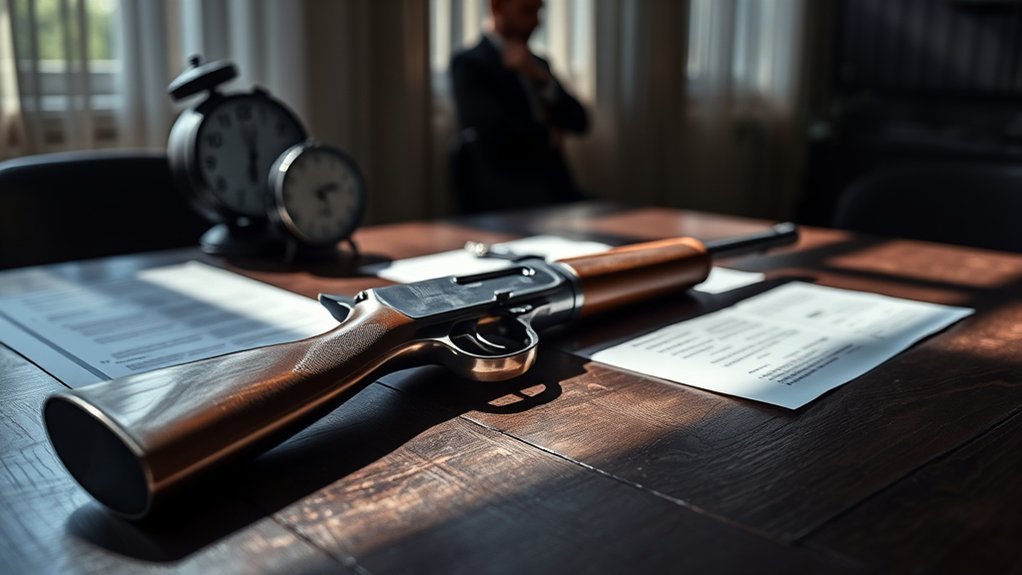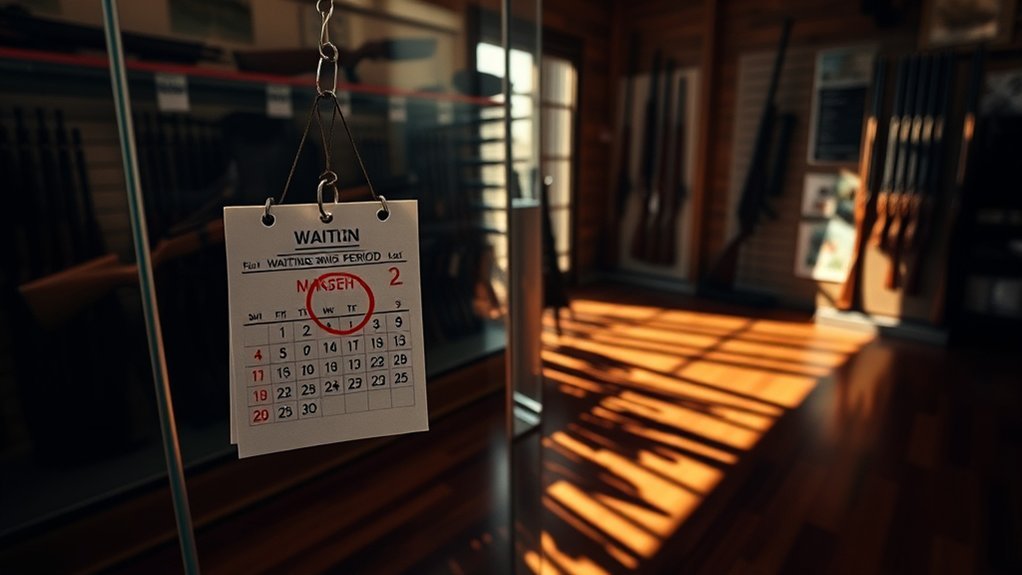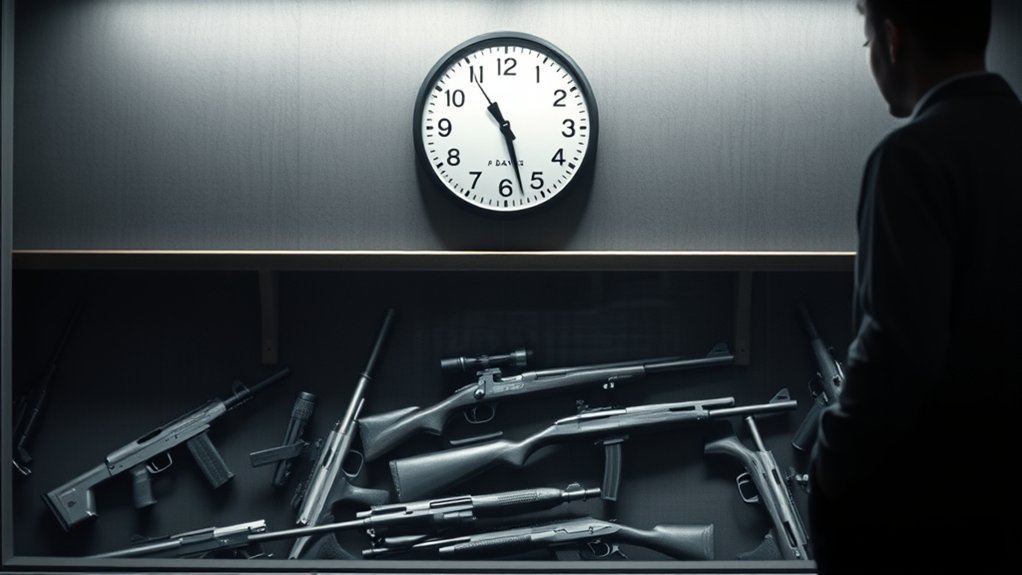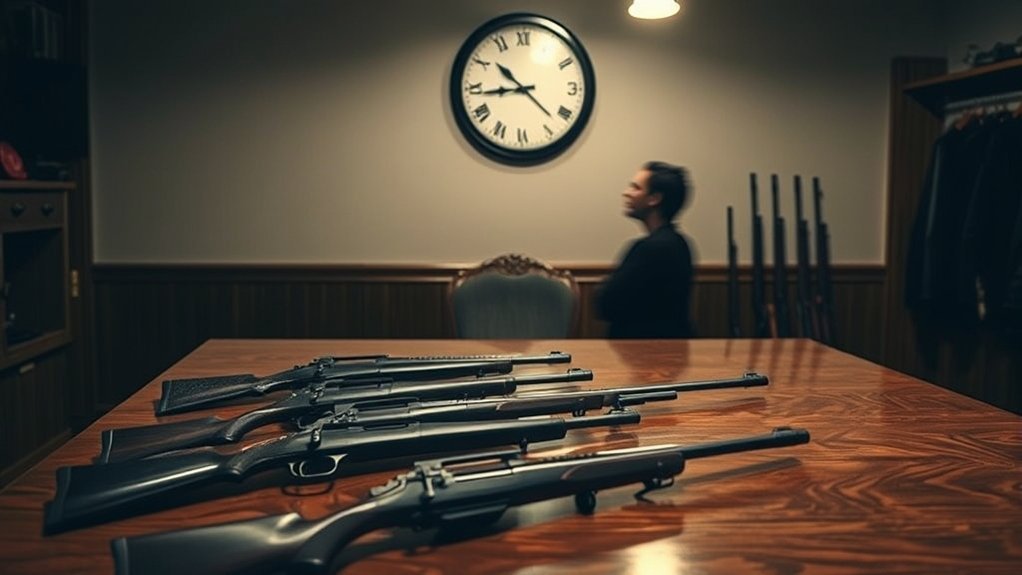Firearm waiting period laws play an essential role in regulating the purchase of guns across various states. These laws aim to provide a buffer between the decision to buy a firearm and the actual transfer of ownership. By understanding their purpose and effectiveness, you can better grasp the ongoing debates surrounding them. What implications do these laws have on violence rates and individual rights? The answers might surprise you.
Understanding Firearm Waiting Period Laws

While you may be enthusiastic to purchase a firearm, understanding waiting period laws is vital in navigating the legal landscape of gun ownership. These laws vary considerably between jurisdictions, often requiring a specified duration between your purchase and the time you can take possession of the firearm. This waiting period can range from a few days to several weeks and is typically intended to allow background checks and other legal processes to be completed. It’s essential to familiarize yourself with the specific regulations in your state or locality, as violating these laws can lead to serious legal consequences. By understanding these provisions, you can guarantee a smoother shift into responsible firearm ownership while adhering to the law.
The Purpose Behind Waiting Periods

Firearm waiting periods serve an essential function by aiming to reduce impulsive decisions that can lead to tragic consequences. By implementing these delays, lawmakers seek to enhance public safety and give individuals time to reconsider their actions. Understanding this purpose can clarify the rationale behind such laws and their potential impact on communities.
Reducing Impulsive Decisions
Waiting periods for firearm purchases serve a critical function by providing a buffer against impulsive decisions that can lead to tragic outcomes. When individuals face emotional distress or momentary crises, the impulse to purchase a firearm can result in irreversible actions. By implementing a waiting period, you create an opportunity for reflection and evaluation of the decision. This time allows individuals to reconsider their motivations and circumstances, potentially preventing regretful actions. Studies indicate that waiting periods can lead to a significant reduction in suicides and gun violence. Consequently, these laws aim to mitigate the risks associated with rash decisions, ensuring that firearm ownership is approached with greater deliberation and care.
Enhancing Public Safety
Although many view waiting periods as a mere inconvenience, they play an essential role in enhancing public safety. These laws serve to create a buffer between the decision to purchase a firearm and actual possession, which can help reduce the risk of gun violence and accidents. Here are three key ways waiting periods contribute to safety:
- Cooling-off Time: They provide individuals in emotional distress time to reconsider their decision, potentially preventing impulsive acts of violence.
- Background Checks: Waiting periods allow for thorough background checks, ensuring firearms don’t fall into the hands of those with criminal intentions.
- Public Awareness: They encourage responsible gun ownership by promoting a culture of safety and mindfulness regarding firearm use.
In these ways, waiting periods serve as a critical public safety measure.
Effectiveness of Waiting Periods in Reducing Violence

To evaluate the effectiveness of firearm waiting periods in reducing violence, you should consider how these laws impact impulse purchases. Analyzing studies and statistics reveals varying outcomes, and state-by-state variations further complicate the assessment. By examining these factors, you can better understand the overall influence of waiting periods on violent incidents.
Impact on Impulse Purchases
When individuals face a mandatory waiting period before purchasing a firearm, the goal is often to curb impulse purchases that may lead to violent acts. This delay allows potential buyers to reassess their motivations and intentions. Here are three key impacts of waiting periods on impulse purchases:
- Reflection Time: You have a chance to evaluate your emotional state and motivations, potentially reducing rash decisions fueled by anger or distress.
- Cooling Off: A waiting period can help diffuse heightened emotions, allowing for clearer thinking and more responsible choices.
- Evaluation of Consequences: It encourages you to think about the long-term implications of buying a firearm, promoting a more deliberate decision-making process.
These factors collectively aim to enhance public safety and reduce impulsive violence.
Studies and Statistics
Numerous studies demonstrate that waiting periods can greatly reduce gun violence. Research shows that these laws give individuals time to reconsider impulsive decisions, particularly during crises. For instance, a study in California found a significant decline in firearm homicides after implementing a 10-day waiting period. Similarly, states with mandatory waiting periods report lower suicide rates involving firearms.
| Study Location | Impact on Homicides | Impact on Suicides |
|---|---|---|
| California | -15% | -10% |
| New York | -12% | -8% |
| Connecticut | -20% | -14% |
These statistics suggest that waiting periods can serve as an effective tool in violence prevention, promoting a safer environment for all.
State-by-State Variations
While the effectiveness of waiting periods in reducing gun violence can vary greatly from state to state, understanding these differences is essential for shaping effective policies. Here’s how different states approach waiting periods and their impacts:
- State Legislation: Some states, like California and New York, have implemented longer waiting periods, reportedly seeing a decline in gun-related suicides and homicides.
- Enforcement and Compliance: States with strict enforcement mechanisms tend to experience more significant reductions in impulsive acts of violence, highlighting the importance of compliance.
- Cultural Factors: The cultural attitudes toward firearms in states like Texas versus Massachusetts can influence the overall effectiveness of waiting periods, reflecting the need for tailored approaches.
Recognizing these variations helps inform more effective strategies to address gun violence across the nation.
Variations in State Regulations
Firearm waiting period laws vary considerably across states, reflecting diverse approaches to gun control and public safety. Some states impose a waiting period of just a few days, while others require up to two weeks. Additionally, certain states apply these laws uniformly for all firearm purchases, whereas others differentiate between handguns and long guns. In some jurisdictions, exceptions exist for individuals with concealed carry permits or law enforcement officials. Furthermore, states like California and New York have implemented strict regulations, while others, such as Texas and Arizona, have opted for no waiting period at all. Understanding these variations is essential for anyone traversing the legal landscape of firearm purchases in the United States.
Controversies and Criticisms
Although waiting period laws aim to enhance public safety, they often spark intense debate among lawmakers, advocates, and the public. Critics argue these laws might not greatly reduce gun violence, suggesting they primarily inconvenience law-abiding citizens. Here are three common criticisms:
Waiting period laws ignite debate, with critics questioning their effectiveness and impact on law-abiding citizens.
- Ineffectiveness: Studies show mixed results on whether waiting periods actually lower gun-related crimes.
- Emergency Situations: In cases of self-defense or urgent threats, delays can endanger lives, preventing individuals from obtaining necessary protection promptly.
- Criminals’ Disregard: Those intent on committing crimes typically bypass legal requirements, rendering waiting periods ineffective against them.
These controversies highlight the complex balance between regulation and individual rights, making the discussion around waiting periods both crucial and contentious.
The Future of Waiting Period Laws in America
As public discourse around gun control evolves, the future of waiting period laws in America remains uncertain. Increased polarization on gun policy will likely influence how states approach these regulations. Some lawmakers may push for stricter waiting periods to enhance public safety, while others might advocate for their repeal, citing personal freedom and the right to bear arms. Public opinion will play a significant role, as citizens weigh the balance between safety measures and individual rights. Legal challenges may arise, particularly if new federal legislation attempts to standardize waiting periods. Ultimately, you should expect ongoing debates that reflect broader societal values, shaping the trajectory of waiting period laws in the coming years.
Conclusion
In the landscape of firearm legislation, waiting period laws act as a cautious dam, slowing the rush of impulsive decisions that could lead to violence. While effectiveness varies across states, the ongoing debates illuminate the complexities of balancing rights and safety. As society navigates these turbulent waters, the future of waiting period laws remains uncertain, shaped by evolving public sentiment and legislative action. Ultimately, these laws reflect a broader quest for harmony in a fragmented dialogue on gun control.

